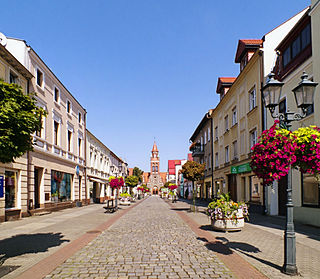
Cedynia is a small historic town in Poland, and the administrative seat of Gmina Cedynia in Gryfino County, West Pomeranian Voivodeship. It is situated close to the Oder river and the border with Germany. The town is known for the 972 Battle of Cedynia, the first historically recorded battle of Poland.

Grodzisk Wielkopolski is a town in western Poland, in Greater Poland Voivodeship (Wielkopolskie), with a population of 13,703 (2006). It is 43 kilometres (27 mi) south-west of Poznań, the voivodeship capital. It is the seat of Grodzisk Wielkopolski County, and also of the smaller administrative district called Gmina Grodzisk Wielkopolski. It is situated on the Letnica River. The suffix "Wielkopolski" distinguishes it from the town of Grodzisk Mazowiecki in east-central Poland.

Kolach or kalach is a traditional bread found in Central and Eastern European cuisines, commonly served during various special occasions – particularly wedding celebrations, Christmas, Easter, and Dożynki. The name originates from the Old Slavonic word kolo (коло) meaning "circle" or "wheel". Korovai is sometimes categorised as a type of kolach.

Zwoleń County is a unit of territorial administration and local government (powiat) in Masovian Voivodeship, east-central Poland. It came into being on January 1, 1999, as a result of the Polish local government reforms passed in 1998. Its administrative seat and only town is Zwoleń, which lies 104 kilometres (65 mi) south-east of Warsaw.

Witkowo is a town in Gniezno County, Greater Poland Voivodeship, Poland, located southeast of Poznań.

Sława is a town in Wschowa County, Lubusz Voivodeship, in western Poland, with 4,321 inhabitants (2019). It is situated on the eastern shore of Lake Sławskie.

Poręba is a town in Zawiercie County, Silesian Voivodeship, Poland, with 8,525 inhabitants (2019). The town has the area of 40 km2 (15 sq mi), and lies along National Road Nr. 78; it also has a rail station on a line from Miasteczko Śląskie to Zawiercie. Almost half of Poręba's area (49%) is covered by forests.

Szałot is a Silesian potato salad. It can be made with diced, boiled potatoes, carrots, peas, ham, various sausages, fish, boiled eggs, and bonded with olive oil or mayonnaise. There are many variations on the dish. In 2006, szałot was placed on the Polish Ministry of Agriculture and Rural Development's list of regional and traditional foods.

Siedlisko is a village on the Oder river in Nowa Sól County, Lubusz Voivodeship, in western Poland. It is the seat of the gmina called Gmina Siedlisko. It lies approximately 8 kilometres (5 mi) south-east of Nowa Sól and 29 km (18 mi) south-east of Zielona Góra.

Piekło is a village in the administrative district of Gmina Sztum, within Sztum County, Pomeranian Voivodeship, in northern Poland. It lies approximately 12 kilometres (7 mi) west of Sztum and 51 km (32 mi) south of the regional capital Gdańsk.

Redykołka is a type of cheese produced in the Podhale region of Poland. It is sometimes known as the "younger sister" of the Oscypek cheese and the two are occasionally confused. The similarity comes from the fact that redykołka is traditionally made using leftover Bundz from Oscypek production.

Pampuchy are a type of steamed yeast dumpling (kluski) or doughnut (pączek) in Polish cuisine. A cooked pampuch (sing.) has an oval, flat on the bottom shape, with a bouncy, mushy and soft consistency. Pampuchy or bułki na parze are served hot: either sweet or savoury.
Opole cuisine is an umbrella term for all dishes with a specific regional identity belonging to the region of Opole. It is a subtype of Polish and German cuisine with many similarities to and signs of the influence of neighbouring cuisines.
Podlaskie cuisine is an umbrella term for all dishes with a specific regional identity belonging to the region of Podlaskie. It is a subtype of Polish, Lithuanian and Belarusian cuisine with many similarities to and signs of the influence of neighbouring cuisines.
Lublin cuisine is an umbrella term for all dishes with a specific regional identity belonging to the region of Lublin. It is a subtype of Polish and Galician cuisine with many similarities to and signs of the influence of neighbouring cuisines.
Świętokrzyskie cuisine is an umbrella term for all dishes with a specific regional identity belonging to the region of Świętokrzyskie. It is a subtype of Polish and Galician cuisine with many similarities to and signs of the influence of neighbouring cuisines.

Cebularz is a wheat dough pancake in Polish and Ashkenazi Jewish cuisine, with a diameter of 15-20 cm, topped with diced onion and poppy seed (15-20%), characteristic for Lublin cuisine.

Sudetes Foothills or Sudeten Foreland is an area (macroregion) located north of the Sudetes proper, being connected with them, but separated from the Sudetes by a distinct tectonic line. The bulk of the region is located within Poland and a small portion is part of the Czech Republic.





















